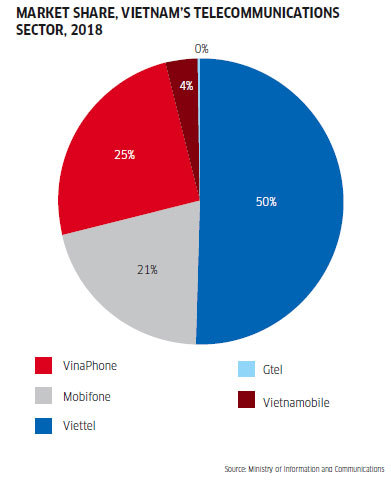 |
Indochina Telecom, the Vietnamese mobile virtual network operator (MVNO), officially relaunched in April after ten years out of the country’s telecommunications market.
Having failed to negotiate a deal with Viettel - the leading local mobile network operator (MNO) - this time around Indochina Telecom is operating on the Vinaphone network, the mobile subsidiary of the Vietnam Posts and Telecommunications Group (VNPT).
The “newcomer” expects to contribute to improving the nature and quality of services in Vietnam’s information and telecommunications industry, sharing the burden of infrastructure investment and operations with other companies, said Mr. Luu Anh Son, Deputy CEO of Indochina Telecom (ITelecom).
Back in the game
Back in 2012, after ITelecom failed to roll out commercial services after a few years of effort, the Ministry of Information and Communications (MoIC) cancelled its license.
At that time, another MVNO license was approved for the State-owned VTC Telecom, but it also failed to launch mobile services.
The return of ITelecom sees it become the sixth telecoms provider in the market, despite the market being saturated in recent years, which makes local insiders wonder how it can earn a profit.
But the company believes it possesses advantages in its new business model, and will focus on niche markets and targeted customers to turn challenges into opportunities, Mr. Son told VET.
ITelecom will initially introduce services for workers at industrial parks in nine cities and provinces.
According to its research, spending on telecom services by these workers is about VND80,000 ($3.4) each per month and so are the target segment in the first stage. It then plans to reach 15 million workers at industrial parks around the country.
It will introduce a variety of packages tailored to different groups and user segments, and will cooperate with local MNOs that have unused mobile phone capacity to negotiate the best deals.
“We will create the most convenient services at reasonable cost, which will make the market compete fairly,” Mr. Son added. “There are still a lot of niche segments that MNOs find hard to exploit.”
In theory, a focus on niche markets is one of the model’s competitive advantages, which its competitors either find challenging to address or have addressed in a different manner.
Successful MVNOs around the world have effectively applied three key factors: an understanding of the target segment, better distribution channels, and lean operations.
Another MNVO, the Malaysia-based
 |
RedONE, told VET of its plan to cooperate with VNPT to launch a new business in Vietnam this year.
The two sides have signed a cooperation agreement and are now preparing for the upcoming launch. Established in 2012, RedONE has received MNVO Service Provider of the Year awards for three consecutive years.
It reached 1 million post-paid subscribers in just under three years, and its goal is to become the largest MNVO in ASEAN.
The penetration of the foreign company increases the total of mobile network operators in Vietnam to seven.
Room to grow
Vietnam’s telecoms market is dominated by the three largest MNOs - Viettel, Vinaphone, and MobiFone - which hold a combined market share of more than 90 per cent in mobile and broadband services.
Growth in total revenue in the industry comes mainly from these three giants, standing at $15 billion in 2018 for 6 per cent growth, according to MoIC.
Viettel, who has just made Vietnam one of the first countries in the world to pilot 5G technology, in early May, contributed 60 per cent of total revenue and 70 per cent of total profit in 2018.
MobiFone, meanwhile, saw 7.5 per cent growth in profit in 2018 against 2017. Growth in revenue and profit, however, is tending to slow as the market has witnessed mobile-price competition between players over recent years.
But Mr. Sesto E Vecchi, Managing Partner of Russin & Vecchi - a foreign consulting company in Vietnam - believes there is still room to grow.
The ratio of households with internet access is just 27 per 100. Similarly, only 9.3 per cent of households have fixed-line telephones, though this is a diminishing market.
In addition, the number of mobile subscribers exceeds the population, most of which primarily use 2G services (calls and SMS).
The number of mobile subscribers with 3G data connection is still lower than the global average. 4G subscriber numbers is lower again, and the 5G network is yet to be developed in the country, according to Mr. Vecchi.
He noted that data demand is one the rise in Vietnam and will keep increasing into the future.
MoIC and telecom analysts have forecast that the number of 4G subscribers will rise more than nine-fold from 2019 to 2024.
In addition, under Vietnam’s commitments in trade agreements, the government understands that it must divest from State-owned enterprises, including telecommunications enterprises, and MobiFone and VNPT plan to have their IPOs completed this year and next, respectively.
“This presents a huge opportunity for foreign investors to invest in the telecoms market if indeed divestment does occur and if bidding is open and appropriate,” Mr. Vecchi said.
Mr. Son believes that participation by foreign MNVOs and other newcomers will create fair competition between telecoms providers and help them gain more opportunities to develop and improve products and services to provide the best value possible for customers.
VNPT recorded the highest profit growth among the three giants in 2018. Recognizing that revenue from traditional mobile services is going down, the group plans to change to a mobile-data business model.
It also plans to outlay $1 billion on merger and acquisitions (M&As) of domestic and foreign tech enterprises over the next two years, as part of adopting a business model in line with digital transformation.
Other State-owned telecoms companies have also switched their business strategy to differentiate themselves and serve cross-border partnerships in areas of mobile payments, digital marketing, cyber security, and cloud-based services.
Opportunities exist for foreign exporters in providing equipment and infrastructure and value-added services, such as developing wireless and alternative broadband technologies and partnering with established network operators to provide 3G/4G/5G services, pay TV infrastructure, and media broadcasting services, according to Mr. Chu Bao Khanh, Associate at Russin & Vecchi.
“Since the satellite-based telecom market is not yet developed in Vietnam, we think there is an opportunity for foreign companies to provide satellite services into the country on a cross-border basis,” he added.
Encouragement policies
2019 will be another year of much change, like 2018, due to MoIC’s mobile number portability (MNP) policy and other polices that will re-draw the market share among telecom companies.
This makes them feel more pressure to retain subscribers, in which they need to provide services with high quality.
ITelecom and RedONE will also face challenges, as they depend on the VNPT network, needing solid partnerships with the corporation to gain competitive price policies as well as distribution networks.
In theory, MNOs limit MVNOs in exploiting distribution areas where the MNO has stable share market.
Mr. Son said ITelecom will propose telecoms management policies to MoIC that will help the price model in buying wholesale and selling retail.
The introduction of 4G services is expected to generate a spike in new opportunities for investors, especially as the industry has been moving towards digital and data products, and local telecoms providers have continued to improve their services.
MoIC is encouraging the development of broadband infrastructure to complete the 4G network and begin work on 5G as early as possible, to enhance the performance of the Internet of Things (IoT).
The ministry has also proposed policy incentives to attract new foreign investments in telecommunications and information technology.
The government hopes more tech companies will invest in Vietnam, as foreign investment has played a major role in the development of the industry.
Mr. Vecchi said that with Vietnam joining the Comprehensive and Progressive Agreement for Trans-Pacific Partnership (CPTPP) and the EU-Vietnam Free Trade Agreement (EVFTA), it is clear that the country intends to open up its telecoms market, well beyond its current WTO commitments. VN Economic Times
Nghi Do

Does Huawei have a chance to grasp share in Vietnam’s 5G deployment?
Three major mobile carriers in Vietnam have recently announced information of cooperation plans with foreign partners in the roadmap of 5G implementation but no one has mentioned Huawei.

More mobile networks join Vietnam's telecom market
The telecom network is expecting to receive more mobile network operators, but analysts say the existing networks are ‘more than enough’ for Vietnam.

5G warmly welcomed in Vietnamese telecommunications market
The pilot of 5G technology is planned to be carried out in 2019 in Vietnam so that in 2020, the country will become one of the first in the world to formally offer this service.
 New entrants will face certain obstacles given the changes in Vietnam's telecoms market, though interest from foreign investors remains.
New entrants will face certain obstacles given the changes in Vietnam's telecoms market, though interest from foreign investors remains.